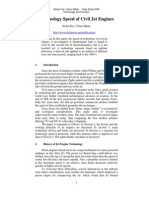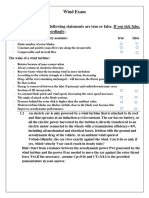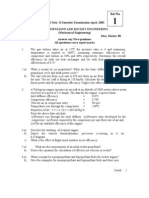0 ratings0% found this document useful (0 votes)
MEEN315-Homework Assignment #15-Extra Credit : A C V F
MEEN315-Homework Assignment #15-Extra Credit : A C V F
Uploaded by
Chandra SekharThis document outlines a homework assignment to model the performance of a military turbojet engine using a Brayton cycle. Students are asked to:
1) Develop a Brayton cycle propulsion model to determine the thrust force, propulsion efficiency, and maximum speed of an F-16 aircraft cruising at 30,000 feet using given engine specifications and assumptions.
2) The model considers the mass flow rate, pressure ratio, turbine inlet temperature, compressor and turbine efficiencies, and negligible kinetic energy changes in the engine.
3) Thrust is determined from the mass flow rate and difference between exhaust velocity and aircraft velocity. Drag increases with the square of velocity based on given coefficients and frontal area.
Copyright:
© All Rights Reserved
Available Formats
Download as PDF, TXT or read online from Scribd
Download as pdf or txt
MEEN315-Homework Assignment #15-Extra Credit : A C V F
MEEN315-Homework Assignment #15-Extra Credit : A C V F
Uploaded by
Chandra Sekhar0 ratings0% found this document useful (0 votes)
This document outlines a homework assignment to model the performance of a military turbojet engine using a Brayton cycle. Students are asked to:
1) Develop a Brayton cycle propulsion model to determine the thrust force, propulsion efficiency, and maximum speed of an F-16 aircraft cruising at 30,000 feet using given engine specifications and assumptions.
2) The model considers the mass flow rate, pressure ratio, turbine inlet temperature, compressor and turbine efficiencies, and negligible kinetic energy changes in the engine.
3) Thrust is determined from the mass flow rate and difference between exhaust velocity and aircraft velocity. Drag increases with the square of velocity based on given coefficients and frontal area.
Original Description:
sdf
Original Title
2cc1e7199c2a0f3835f2a398d2932e45_b743237e45fefadfc57ec465c30dca2f (1)
Copyright
© © All Rights Reserved
Available Formats
PDF, TXT or read online from Scribd
Share this document
Did you find this document useful?
Is this content inappropriate?
This document outlines a homework assignment to model the performance of a military turbojet engine using a Brayton cycle. Students are asked to:
1) Develop a Brayton cycle propulsion model to determine the thrust force, propulsion efficiency, and maximum speed of an F-16 aircraft cruising at 30,000 feet using given engine specifications and assumptions.
2) The model considers the mass flow rate, pressure ratio, turbine inlet temperature, compressor and turbine efficiencies, and negligible kinetic energy changes in the engine.
3) Thrust is determined from the mass flow rate and difference between exhaust velocity and aircraft velocity. Drag increases with the square of velocity based on given coefficients and frontal area.
Copyright:
© All Rights Reserved
Available Formats
Download as PDF, TXT or read online from Scribd
Download as pdf or txt
0 ratings0% found this document useful (0 votes)
MEEN315-Homework Assignment #15-Extra Credit : A C V F
MEEN315-Homework Assignment #15-Extra Credit : A C V F
Uploaded by
Chandra SekharThis document outlines a homework assignment to model the performance of a military turbojet engine using a Brayton cycle. Students are asked to:
1) Develop a Brayton cycle propulsion model to determine the thrust force, propulsion efficiency, and maximum speed of an F-16 aircraft cruising at 30,000 feet using given engine specifications and assumptions.
2) The model considers the mass flow rate, pressure ratio, turbine inlet temperature, compressor and turbine efficiencies, and negligible kinetic energy changes in the engine.
3) Thrust is determined from the mass flow rate and difference between exhaust velocity and aircraft velocity. Drag increases with the square of velocity based on given coefficients and frontal area.
Copyright:
© All Rights Reserved
Available Formats
Download as PDF, TXT or read online from Scribd
Download as pdf or txt
You are on page 1/ 1
MEEN315-Homework Assignment #15-Extra Credit*
Due: 9 Dec 2014 4PM (MEOB 412)
Topic: Jet Propulsion Cycle
Chapter(s): Chapter 9
*Scoring for this homework will be: 2 pts per answer with supporting calculations; 3 pts per correct
answer with supporting calculations. Extra credit points will be added to cumulative homework score.
Introduction: In this problem will model the performance of a military turbojet (F-16C) using a non-ideal
Brayton turbojet cycle (diffuser-compressor-combustor-turbine-nozzle). For our model we will use the
following assumptions and approximate data from published information*: a) mass flow rate through engine of
120 kg/s, b) pressure ratio 30:1, c) turbine inlet temperature of 1800 K, d) compressor and turbine efficiencies
of 85%, e) negligible kinetic energy between diffuser outlet and nozzle inlet. We will model our performance
for an aircraft cruising at maximum speed at an altitude of 30,000 ft (assume air conditions are 220 K and 25
kPa). The drag force on the aircraft increases with the square of aircraft speed, and is given by:
FD
1
V 2 CD Af
2
Where F is the drag force, is the density of the air, V is the aircraft velocity, CD is the dimensionless drag
coefficient (0.021), and Af is the frontal area of the jet (assume 28 m2). Recall that thrust force is given by:
.
FT m Ve V
Where FT is the thrust force, m-dot is the mass flow rate of air through the engine, and Ve is the exhaust nozzle
velocity.
Figure 1.: GE F100 Turbojet engine; F-16 military aircraft.
http://www.geaviation.com/engines/military/f110/f110-100-400.html;
http://www.ausairpower.net/engines.pdf
http://www.cs.odu.edu/~mln/ltrs-pdfs/tp3355.pdf
Problem #1: Using the information given, develop a Brayton cycle propulsion model and determine: a) the
thrust force, b) the propulsion efficiency, c) the maximum speed of the aircraft (m/s, no afterburner).
You might also like
- A Transport Aft-Turbofan 59-GTP-20: B. E. Sells - W. R. DodgeNo ratings yetA Transport Aft-Turbofan 59-GTP-20: B. E. Sells - W. R. Dodge9 pages
- Aspect Regarding of The Pratt & Whitney F100 Jet Engine Performances100% (1)Aspect Regarding of The Pratt & Whitney F100 Jet Engine Performances8 pages
- A Technique To Determine Lift and Drag Polars in FlightNo ratings yetA Technique To Determine Lift and Drag Polars in Flight7 pages
- Study On Regulating Law of Two-Stage Turbo Charger System of Piston Aircraft EngineNo ratings yetStudy On Regulating Law of Two-Stage Turbo Charger System of Piston Aircraft Engine6 pages
- ME 2351 Gas Dynamics and Jet Propulsion Unit 4No ratings yetME 2351 Gas Dynamics and Jet Propulsion Unit 414 pages
- Estimation of Wing Loading and Thrust Loading - 8 Topics: Example 4.19No ratings yetEstimation of Wing Loading and Thrust Loading - 8 Topics: Example 4.198 pages
- Turbo-Electric Propulsive Fuselage Aircraft BLI Benefits: A Design Space Exploration Using An Analytical MethodNo ratings yetTurbo-Electric Propulsive Fuselage Aircraft BLI Benefits: A Design Space Exploration Using An Analytical Method22 pages
- Conceptual Development of Quiet Turbofan Engines For Supersonic AircraftNo ratings yetConceptual Development of Quiet Turbofan Engines For Supersonic Aircraft9 pages
- Performance Cycle Analysis On Turbo Fan Engine PW4000: Shray Benawra, Jiqiang Wang, Hong Yue, Georgi DimirovskyNo ratings yetPerformance Cycle Analysis On Turbo Fan Engine PW4000: Shray Benawra, Jiqiang Wang, Hong Yue, Georgi Dimirovsky6 pages
- Practice Problem: ME 322 - Mechanical Engineering Thermodynamics Spring 2020 Homework #27No ratings yetPractice Problem: ME 322 - Mechanical Engineering Thermodynamics Spring 2020 Homework #271 page
- Selecting Fuel Fraction, Propeller Diameter and Fuselage Length For Military Propeller TrainersNo ratings yetSelecting Fuel Fraction, Propeller Diameter and Fuselage Length For Military Propeller Trainers9 pages
- Aerodynamic Design of An Extended Range BombNo ratings yetAerodynamic Design of An Extended Range Bomb2 pages
- NR-420301-Jet Propulsion & Rocket EngineeringNo ratings yetNR-420301-Jet Propulsion & Rocket Engineering8 pages
- Small Unmanned Fixed-wing Aircraft Design: A Practical ApproachFrom EverandSmall Unmanned Fixed-wing Aircraft Design: A Practical ApproachNo ratings yet
- Reducing Business Jet Carbon Footprint: Using the Power of the Aircraft Electric Taxi SystemFrom EverandReducing Business Jet Carbon Footprint: Using the Power of the Aircraft Electric Taxi SystemNo ratings yet
- Business Partner Proposal: Vistamind Education PVT LTDNo ratings yetBusiness Partner Proposal: Vistamind Education PVT LTD12 pages
- Electronic Effects, Acid-Base Strength and Reaction IntermediatesNo ratings yetElectronic Effects, Acid-Base Strength and Reaction Intermediates28 pages
- Resonasdfance AIEEE IIT Study Material Maths CompleteNo ratings yetResonasdfance AIEEE IIT Study Material Maths Complete341 pages
- Surface TensionpdfFilename: Surface Tensionpdf PDFNo ratings yetSurface TensionpdfFilename: Surface Tensionpdf PDF18 pages










































































